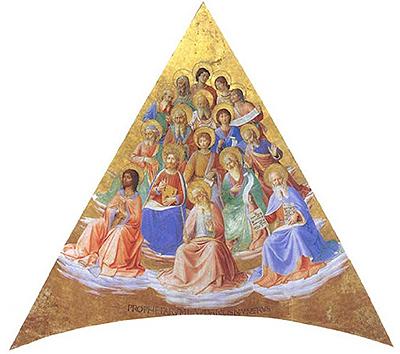Fra Angelico created several frescoes in the Chapel of San Brizio, Orvieto. These were produced in the summer of 1447, and he would call upon the services of some of his assistants in order to complete both Sixteen Prophets as well as Christ Seated in Judgment.
The two frescoes feature similar content, with beautifully crafted figures in similar tones of colour. They also have backgrounds with a heavy use of golden paint which leaves behind a bold and impactful finish. The Sixteen Prophets featured a triangular format in order to fit into the wall installation within the chapel, and the full area is covered with an arrangement of prophets who slowly reduce in size as we move upwards across the painting. Fra Angelico limits the tones of colour to keep things consistent, choosing to use pink, blue and green to fulfil the clothing of each figure. This brightness works perfectly against the contrasting golden paint and then some writing is added to the bottom of the painting in order to help the viewer to understand more about the prophet's identities. The artist then adds cloud formations just below some of the figures, giving the impression of them floating in the sky.
The way in which Christ dominates over all others would continue again into Last Judgement by Michelangelo, which perhaps suggests some level of influence on the later master. The overall ceiling and wall display was planned to work consistently and fluidly, meaning individual frescoes would have to work smoothly with their neighbouring artworks. The original architectural style of the chapel was Gothic and this would mean that there would be all manner of small regions with strange angles, not ideal for the fresco painters as they sought to plan and deliver a complex arrangement of artworks. Fra Angelico's approach to the Sixteen Prophets is calmer and more graceful than most of the other interpretations producing across the 15th and 16th century.
The prophets are all fairly rigid in manner, sat upright without too much interaction other than a little between the smaller figures close to the top. Each one is provided by an object or action to make each one unique, some with small pages of scripture, for example. This would help to underline their purpose and identity, but from the floor of the chapel it would actually be impossible to spot these subtle details, sadly. Some elements of the work in this building was completed by Luca Signorelli, following on several decades later after the artist had already passed away. This procession of artists was common because of the relatively short life spans experienced at that time, and also in how some of these projects could take years to complete.




